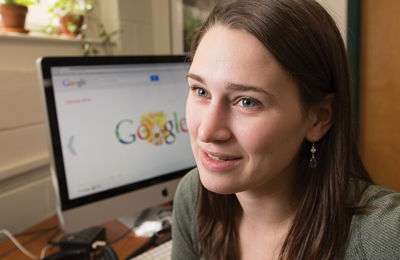Classes Fueled by SPEED

Mallory Pitser ’14 aims to use her computer science major to help people “get things done more quickly and intuitively, so they can do what matters to them with their extra time.” Photo by Laurence Kesterson.
Literacy rates among members of the deaf community are some of the lowest in the country, says Linguistics Professor Donna Jo Napoli. The admitted technophobe and author of more than 70 children’s and young adult novels wondered if the digital world could help her introduce deaf children to literature.To move ahead with the idea, she knew she’d require extensive technological advice and training. She found both through Swarthmore’s Special Projects for Educational Exploration and Design (SPEED) program.
Partnering with Gene Mirus, a professor from Gallaudet University, Napoli created a joint class in fall 2013. Napoli’s extensive summer training with a student intern provided by SPEED helped the class create five bilingual (American Sign Language and English) children’s books, downloadable for free on iTunes.
The SPEED program matches technically savvy student interns with a faculty summer project to develop technology-driven instructional tools, says Michael Kappeler, an academic technologist who oversees intern hiring and much of the SPEED project management. The program, a partnership between the IT department and the libraries, has yielded enormous benefits for faculty grantees, information technology staffers, and student interns alike. As a result, the program has nearly doubled its project load since its inaugural year, 2012.
“The faculty member gets collaborators and dedicated time—which helps them teach their course [innovatively], and the student interns get this great educational experience,” says Eric Behrens ’92, associate chief information technology officer. The grants, which go to projects as simple as a course website or as complicated as constructing 3-D computer models of ancient cities, are awarded to about eight faculty members each summer. Projects must be of a scope that can be completed in eight weeks or fewer, and faculty are strongly encouraged to put the resource to use in the coming academic year, says Kappeler.
Besides working eight-hour days alongside academic technologists, programmers, and librarians, student interns can put their technological acumen into practice. One former SPEED intern, Mallory Pitser ’14, a computer science major, has accepted a job with Google, in part, thanks to her work in 2013. Pitser helped build a database of Crum Woods ecological data for José Luis Machado, associate professor of ecology. “The internship was essentially a boot camp,” says Pitser. We learned about languages, coding, security, libraries, and frameworks—stuff I couldn’t conceptualize before that summer, but now I know how it all fits together.”
Faculty objectives have shifted during SPEED’s three years, says Behrens. “Last year there was a lot of interest in making Web stuff and building applications,” he says. “This year there’s more emphasis on curricular resources like video for flipped instruction.” For instance, some professors, especially scientists, find that working out problem sets on chalkboards can be prerecorded. Students can then watch (and rewatch) at home, so class time can be spent on theory, clarification, or discussion.
Another plus is the program’s funding, about $20,000 per year, according to Behrens. Mostly dedicated to student-intern wages, the money comes from ITS and the library budgets each year.
“The biggest contribution we give is the staff time that goes into training and mentoring the students,” says Behrens, adding that the libraries are full partners in the SPEED program as the College’s in-house experts on metadata, intellectual property, and preservation.
When describing Napoli’s eBooks project, Kappeler’s pride is evident. After all, he was able to pair her with the perfect intern: Jocelyn Adams ’15, a linguistics major proficient in ASL. “We built a wireframe of one of these books, hammered out bugs, and we came up with a plan for implementation,” he says. “But what Donna Jo’s class did with the project took it to a whole other level.”
“I learned so many things that saved my students from pitfalls,” says Napoli, who intends to repeat the joint class, this time with rights to National Geographic’s early-reader series on nonfiction topics such as sharks or dinosaurs. She adds, “I don’t anticipate needing another SPEED grant, but if I did, I’d go begging.”
 Email This Page
Email This Page